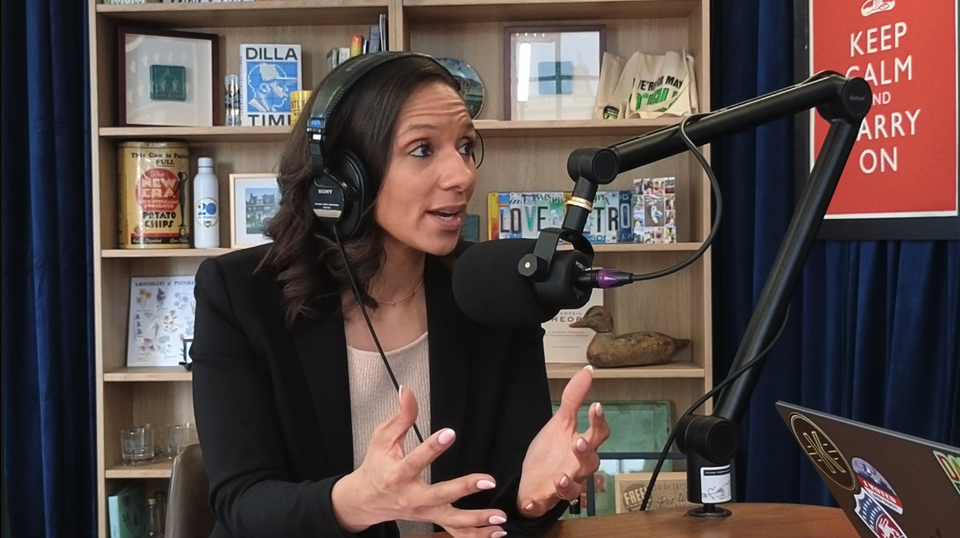At first, you hear the warm voice of Carmen Harlan.
“Grand Circus Park, brought to you by Chevrolet” the recorded message assures the passengers.
Next, you hear some weird, garbled digital voice finishing the sentence, telling you about the attractions at that stop.
That contrast is exactly the QLINE today.
We wanted to step back, let some kinks work out, and then add something. Optimistically, one could think hey, it’ll take some time to iron things out.
We’re now a month in, and the ironing out doesn’t feel like it’s happening. And we need to talk about it. Especially because people ARE using the thing, and that’s great. It’s exciting to see the streetcars go down Woodward, and the sound of their little electronic horn makes one feel like yes, you’re in a big city.
But it also means there is more responsibility to get it right.
After all, regional leaders hold up the QLINE as an example of what could be done when organizations of different kinds cooperate, and what could happen under a greater Regional Transit Authority. When we were at the Mackinac Policy Conference, the CEO of M1 Rail Matt Cullen said in an interview with us he’d like to see more streetcars up various streets like Gratiot, as well as Bus Rapid Transit (BRT) into the neighborhoods and suburbs.
That’s big vision. The current line only goes 3.3 miles – but if well executed, the QLINE could be the example of “dressing for the job you want, not the job you have.”
If it turns into a well-oiled machine, it could definitely turn heads that yes, we can step up our transit game.
But weeks later from its opening, as regular users of the system, it still has some key issues that need to be addressed.
In no particular order:
The estimated wait times are way off

The “estimated” times are a flat out joke. They’re rarely correct. The best guess you have is to watch the little dots with the blue tags for where the next train is, because those minute estimations seem to be never right.
Beyond that, real transit systems don’t have a congratulatory Twitter as the newsfeed. They have service updates. They share if there are slowdowns. Here’s an example of a grown up system’s Twitter account, the San Francisco BART.
It’s not that you can’t have congratulatory notices and fun articles interspersed in the feed. It’s that Twitter is a great way to add transparency to the service. There are literally no service announcements in the feed, when today we can tell you trains ran more than 30 minutes apart.
This isn’t limited to the QLINE. Often in Detroit, it seems like organizations are constantly worried about telling folks what’s going on. But that’s all people want. We get it. Streetcars break down. Accidents happen. Just tell us about it. It becomes a bigger deal when you don’t share information, and then other people end up having to tell your story.
Signal priority

After a few weeks of service, it’s clear that it’s needed and soon. It’s annoying to leave a station and then stopping again ten feet down the road for a red light. Or you’re going along nicely and stopped in the middle of Woodward with no traffic around you. We were told that it would be easier to make happen with a Regional Transit Authority, but y’all can’t wait on this. You could shave a few minutes each way with it.
Scheduled times
We’ve heard this a lot from people who are trying to use this for work on the platforms. The “20 minute interval” thing isn’t working right now, and if there’s a DDOT bus in sight, the key trick if you need to be somewhere on time is grab it at the closest stop. As a regular bus rider, it will get you there faster, guaranteed. Schedules help plan trips.
What stop am I at?

This could be seen as minor, but they can’t seem to get the stops right for the signage in the streetcar. This isn’t a big deal for a seasoned local, but if someone is unfamiliar this is a bad user experience. The city DDOT buses seem to figure it out through GPS and they not only run different lines, they aren’t on a fixed track.
Is six streetcars enough?
During peak demand times, it feels like the system is straining under the weight. It’s a great problem to have. If it continues, it might be time to get more streetcars.
The stations are poorly designed from a practical perspective
They’re pretty, but it’s like being in a glass oven. I sometimes look out the glass and wonder if this is the view my Hot Pocket would have looking out of the microwave.
At most stops there is little shade in and the recent heat makes it miserable to sit there sweltering on a concrete step. They could have done better, and being hot just makes you madder at that incorrect digital sign.
Sure, some of this is on us
A small part of this is we do need to be a bit better about transit etiquette.
Don’t stand in the doorway aisle when someone’s trying to walk their bike off. When the train arrives, get on or get off quickly. When the train starts filling up, if you’re able bodied and your stop isn’t for a few stations, hop up the couple stairs to the front or back. There have been plenty of times the head-in-armpit situation could be alleviated by just spreading out a bit.
Yes, this is tough love for the QLINE. It’s also true that complaining about mass transit service is a tradition in major cities the world over, but in a way it’s a good sign. It’s a sign people care.
Hopefully, the QLINE becomes all it could be and more. It’s one of the most exciting developments in Detroit in decades. Stepping onto it, you can sometimes feel the possibility of Detroit’s future. Let’s push it to be the best it can be.
UPDATE, 6/22: The QLINE announced changes coming this summer, as well as free rides until Labor Day. More here.














